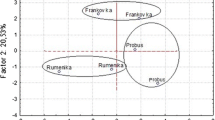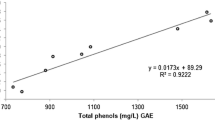Abstract
Crljenak kaštelanski or Tribidrag is a Croatian autochthonous grape variety which is a parent of the America’s most popular variety Zinfandel or Italian Primitivo. The aim of this study was to investigate the dynamics of extraction of phenolics and changes in antioxidant activity of the samples collected during maceration of C. kaštelanski grapes processed using two different macerating enzymes. According to the obtained results it can be concluded that wines from C. kaštelanski grapes are great source of bioactive phenolics although differences in phenolic profiles between control and enzyme-treated wines were detected. The highest content of total phenolics was detected in control wine (2691 mg GAE/L). Use of pectolitic enzyme Vinozym Vintage improved anthocyanin extraction, while higher colour parameters were observed for wine samples produced using Sihazym Extro. The statistical analysis confirmed great influence of total phenolics and concentrations of some individual phenolic compounds (e.g. catechin, gallic acid, epicatechin) on reducing and free radical scavenging activity of wine samples while the impact of anthocyanins was not detected. According to the obtained results it can be concluded that use of enzymes has slightly negative effect on total phenolics and wine antioxidant properties, but it increases the extraction yield of wine colour components what enables shorter maceration and prevents colour losses during the aging process.



Similar content being viewed by others
References
Aguilar T, Loyola C, de Bruijn J, Bustamante L, Vergara C, von Baer D, Mardones C, Serra I (2016) Effect of thermomaceration and enzymatic maceration on phenolic compounds of grape must enriched by grape pomace, vine leaves and canes. Eur Food Res Tech 242:1149–1158. https://doi.org/10.1007/s00217-015-2619-3
Amerine MA, Ough CS (1980) Methods for analysis of musts and wines. Wiley, New York
Bautista-Ortín AB, Fernández-Fernández JI, López-Roca JM, Gómez-Plaza E (2007) The effects of enological practices in anthocyanins, phenolic compounds and wine colour and their dependence on grape characteristics. J Food Comp Anal 20:546–552. https://doi.org/10.1016/j.jfca.2007.04.008
Benzie IFF, Strain JJ (1996) The ferric reducing ability of plasma (FRAP) as measurement of “antioxidant power”: the FRAP assay. Anal Biochem 239:70–77. https://doi.org/10.1006/abio.1996.0292
Cimino F, Sulfaro V, Trombetta D, Saija A, Tomaino A (2007) Radical-scavenging capacity of several Italian red wines. Food Chem 103(1):75–81. https://doi.org/10.1016/j.foodchem.2006.07.042
Dimitrovska M, Bocevska M, Dimitrovski D, Doneva Sapceska D (2015) Evolution of anthocyanins during vinification of Merlot and Pinot Noir grapes to wines. Acta Aliment 44:259–267. https://doi.org/10.1556/066.2015.44.0003
Fernández-Pachón MS, Villaño D, Troncoso AM, García-Parrilla MC (2006) Determination of the phenolic composition of sherry and table white wines by liquid chromatography and their relation with antioxidant activity. Anal Chim Acta 563(1–2):101–108. https://doi.org/10.1016/j.aca.2005.09.057
Fredotović Ž, Šprung M, Soldo B, Ljubenkov I, Budić-Leto I, Bilušić T, Čikeš-Čulić V, Puizina J (2017) Chemical composition and biological activity of Allium cepa L. and Allium × × cornutum (Clementi ex Visiani 1842) methanolic extracts. Molecules 22:1–13. https://doi.org/10.3390/molecules22030448
Generalić Mekinić I, Skroza D, Ristovski B, Ljubenkov I, Bikić I, Svilović S, Banović M, Bocevska M, Katalinić V (2016) Anthocyanidins in Babica, Ljutun and Crljenak Kaštelanski grapes and kinetic of their degradation under different storage conditions. J Food Nutr Res 55(4):294–302
González-Neves G, Favre G, Piccardo D, Gil G (2016) Anthocyanin profile of young red wines of Tannat, Syrah and Merlot made using maceration enzymes and cold soak. Int J Food Sci Tech 51:260–267. https://doi.org/10.1111/ijfs.12958
Harlina PW, Ma M, Shahzad R, Gouda MM, Qiu N (2018) Effect of clove extract on lipid oxidation, antioxidant activity, volatile compounds and fatty acid composition of salted duck eggs. J Food Sci Tech. https://doi.org/10.1007/s13197-018-3367-8
Jackson RS (2000) Wine science, principles, practice, perception. Elsevier Inc., London
Katalinić V, Smole Možina S, Generalić I, Skroza D, Ljubenkov I, Klančnik A (2013) Phenolic profile, antioxidant capacity and antimicrobial activity of crude leaf extracts of six Vitis vinifera L. varieties. Int J Food Prop 16:45–60. https://doi.org/10.1080/10942912.2010.526274
Li H, Wang X, Li Y, Li P, Wan H (2009) Polyphenolic compounds and antioxidant properties of selected China wines. Food Chem 112:454–460. https://doi.org/10.1016/j.foodchem.2008.05.111
López-Vélez M, Martinez-Martinez F, Del Valle-Ribes C (2003) The study of phenolic compounds as natural antioxidants in wine. Crit Rev Food Sci Nutr 43:233–244. https://doi.org/10.1080/10408690390826509
Maletić E, Pejić I, Karoglan Kontić J, Zdunić G, Preiner D, Šimon S, Andabaka Ž, Žulj Mihaljević M, Bubola M, Marković Z, Stupić D, Mucalo A (2015) Ampelographic and genetic characterization of Croatian grapevine varieties. Vitis 54:93–98
Mattivi F, Guzzon R, Vrhovsek U, Stefanini M, Velasco R (2006) Metabolite profiling of grape: flavonols and anthocyanins. J Agric Food Chem 54:7692–7702. https://doi.org/10.1021/jf061538c
Mitić MN, Kostić DA, Pavlović AN (2014) The phenolic composition and the antioxidant capacity of Serbian red wines. Adv Techn 3(1):16–22
Mojsov K, Ziberoski J, Bozinovic Z, Petreska M (2010) A comparison of effects of three commercial pectolytic enzyme preparations in red winemaking. Int J Pure Appl Sci Technol 1(2):127–136. https://doi.org/10.15208/ati.2011.4
Moreno-Arribas MV, Polo C (2009) Wine chemistry and biochemistry. Springer, New York
Ortega-Heras M, Pérez-Magariño S, González-Sanjosé ML (2012) Comparative study of the use of maceration enzymes and cold pre-fermentative maceration on phenolic and anthocyanic composition and colour of a Mencía red wine. LWT Food Sci Technol 48:1–8. https://doi.org/10.1016/j.lwt.2012.03.012
Paixão N, Perestrelo R, Marques JC, Câmara JS (2007) Relationship between antioxidant capacity and total phenolic content of red, rosé and white wines. Food Chem 105:204–214. https://doi.org/10.1016/j.foodchem.2007.04.017
Pardo F, Salinas MR, Alonso GL, Navarro G, Huerta MD (1999) Effect of diverse enzyme preparations on the extraction and evolution of phenolic compounds in red wines. Food Chem 67:135–142. https://doi.org/10.1016/S0308-8146(99)00080-1
Parley A, Vanhanen L, Heatherbelle D (2001) Effects of pre-fermentation enzyme maceration on extraction and colour stability in Pinot Noir wine. Aust J Grape Wine R 7:146–152
Ribéreau-Gayon P, Dubourdieu D, Donèche B (2006) Handbook of enology, volume 2, the chemistry of wine, stabilization and treatments, 2nd edn. Wiley, Chichester
Río Segade S, Pace C, Torchio F, Giacosa S, Gerbi V, Rolle L (2015) Impact of maceration enzymes on skin softening and relationship with anthocyanin extraction in wine grapes with different anthocyanin profiles. Food Res Int 71:50–57. https://doi.org/10.1016/j.foodres.2015.02.012
Romero-Cascales I, Fernández-Fernández JI, Ros-García JM, López-Roca JM, Gómez-Plaza E (2008) Characterisation of the main enzymatic activities present in six commercial macerating enzymes and their effects on extracting colour during winemaking of Monastrell grapes. Int J Food Sci Technol 43:1295–1305. https://doi.org/10.1111/j.1365-2621.2007.01608.x
Singleton VL, Rossi J (1965) Colorimetry of total phenolics with phosphomolybdic-phosphotungstic acid reagents. Am J Enol Vitic 16:144–158
Skroza D, Generalić Mekinić I, Svilović S, Šimat V, Katalinić V (2015) Investigation of the potential synergistic effect of resveratrol with other phenolic compounds: A case of binary phenolic mixtures. J Food Compos Anal 38:13–18
Soto Vázquez E, Río Segade S, Orriols Fernández I (2010) Effect of the winemaking technique on phenolic composition and chromatic characteristics in young red wines. Eur Food Res Technol 231:789–802. https://doi.org/10.1007/s00217-010-1332-5
Sun B, Neves AC, Fernandes TA, Fernandes AL, Mateus N, De Freitas V, Leandro C, Spranger MI (2011) Evolution of phenolic composition of red wine during vinification and storage and its contribution to wine sensory properties and antioxidant activity. |J Agric Food Chem 59:6550–6557. https://doi.org/10.1021/jf201383e
Xia EQ, Deng GF, Guo YJ, Li HB (2010) Biological activities of polyphenols from grapes. Int J Mol Sci 11:622–646. https://doi.org/10.3390/ijms11020622
Zdunić G, Preece JE, Dangl GS, Koehmstedt A, Mucalo A, Maletić E, Pejić I (2013) Genetic characterization of grapevine cultivars collected throughout the Dalmatian region. Am J Enol Vitic 64:285–290. https://doi.org/10.5344/ajev.2012.12085
Zoecklein B, Fugelsang KC, Gump B, Nury FS (1995) Wine analysis and production. Springer, New York
Žulj Mihaljević M, Anhalt UCM, Rühl E, Tomić Mugoša M, Maraš V, Forneck A, Zdunić G, Preiner D, Pejić I (2015) Cultivar identity, intravarietal variation, and health status of native grapevine varieties in Croatia and Montenegro. Am J Enol Vitic 66:531–541. https://doi.org/10.5344/ajev.2015.15023
Acknowledgements
This work has been partially supported by Croatian Science Foundation under the project IP-2013-11-8652. We thank Prof. Vida Šimat for assistance with statistical analysis and suggestions that greatly improved the manuscript.
Author information
Authors and Affiliations
Corresponding authors
Ethics declarations
Conflict of interest
The authors declare that there is no conflict of interest.
Additional information
Publisher's Note
Springer Nature remains neutral with regard to jurisdictional claims in published maps and institutional affiliations.
Rights and permissions
About this article
Cite this article
Generalić Mekinić, I., Skračić, Ž., Kokeza, A. et al. Effect of winemaking on phenolic profile, colour components and antioxidants in Crljenak kaštelanski (sin. Zinfandel, Primitivo, Tribidrag) wine. J Food Sci Technol 56, 1841–1853 (2019). https://doi.org/10.1007/s13197-019-03638-4
Revised:
Accepted:
Published:
Issue Date:
DOI: https://doi.org/10.1007/s13197-019-03638-4




